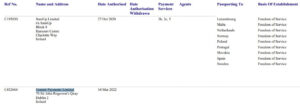Over the last quarter, the underlying risks of CeFi have become evident to the global crypto community. While the accessibility, fixed interests, and cross-chain services of CeFi are unmatched by DeFi services, its lack of transparency and control is significantly concerning for the users. As the recent downfall of Celcius has shown, trusting your digital assets with centralized third parties can be significantly risky, particularly when the bear market kicks in.
Midas Investment, a custodial crypto-investment platform is solving this issue by merging CeFi and DeFi strategies into the innovative CeDeFi model – the best of both worlds. This innovative model combines the user-friendly experience of CeFi with several DeFi strategies that can continuously maintain high-yield prospects and transparency.
Midas has recently launched its new CeDeFi strategy called “GLP” – which generates 20-30% projected ROI (in ETH) for leveraged traders on the GMX exchange. This new strategy is poised to create sustainable income generation opportunities from leveraged traders during any market conditions.
What is the GLP CeDeFi strategy?
GLP is the new index liquidity provision strategy innovated by Midas Investments. It provides blue-chip liquidity for leveraged traders on GMX, a decentralized perpetual exchange. How does it work?
Users on the GMX exchange supply liquidity into the GLP index. They earn a variable fee generated from the trader’s liquidation and from trader losses in the exchange. This strategy allows leveraged traders to retain 20-30% APR in ETH.
The GLP index is very unique in terms of how its formulated. Nearly 98% of the index is composed of tier-1 tokens, including Bitcoin (BTC), Ethereum (ETH), and major stablecoins such as FRAX, USDC, USDT, and DAI. The stablecoins account for around 45% of the index, while the remaining 55% are BTC and ETH. So, when users buy GLP shares for stablecoins, they will also effectively enter a 0.25x soft long position on Bitcoin and Ethereum.
This unique indexing mechanism will allow GLP shareholders to generate a strong and sustainable leveraged income. Once the strategy is launched, Midas will issue GLP shares for its users through the index token, which they can swap into on the GMX exchange.
What are the sources of yield in GLP?
GLP rewards its leveraged shareholders from two distinct sources. Around 20% of the yield comes from the fees paid by the traders when opening and closing their leveraged positions on the GMX exchange. Basically, for liquidation, they swap assets using GLP liquidity, which ultimately contributes a portion of the fees to the index shareholders.
The second source of rewards is the losses incurred by traders. When traders lose money on the crypto market, their net losses are GLP’s net profits. Around 85% of the GLP yield comes from this source. Rewards are always given in ETH.
The pros and cons of the GLP index strategy
GLP is a very low-risk investment strategy to receive exposure to BTC and ETH. What’s more unique is that the index will particularly perform well during any market conditions, when traders are most likely to lose money. Being a liquidity index provision, GLP can potentially grow during high volatility, because most traders will experience negative PnL (profit and loss). This functional mechanism provides a high and sustainable yield for GLP holders.
In terms of cons, users should understand that GLP is not the same as a single-sided liquidity provision. When depositing a token of their choice to buy the index shares, they will inevitably gain exposure to other tokens on the exchange. For instance, you might be depositing a stablecoin, but your index share will also be exposed to BTC and ETH. So, if one of the tokens in the index loses its value, GLP will lose value too. Also, in a bull market, trader profits will incur net losses on the index.
Is CeDeFi the future?
As the new GLP strategy from Midas shows, CeDeFi can potentially solve a lot of the major issues in the leverage trading market. By deploying such strategies on DeFi protocols, platforms can maintain transparency and high yield prospects. However, being governed by a custodial platform like Midas, the ease-of-access and comprehension are still intact.
CeDeFi provides a very simple and easy approach to hedged complicated DeFi strategies which use several protocols to generate yield and are hard to be managed in one hand due to changes of market conditions,volatility, liquidity volume changes, and etc.. At the same time, allowing users to have full transparency and control over their funds.
Midas Investments is innovating this CeDeFi model to lower the high-entry barrier of crypto and DeFi. Leveraging the CeDeFi model has allowed the platform to provide vetted yield opportunities at lower fees for its investors. First three CeDeFi investment strategies “Soft Long”, “Soft Short”, and “DeFi Token Farming” just a month ago, showed great user interest and gathered more than $4 million TVL from more than 1,500 active users.
Midas is the first crypto platform to transparently talk about yield strategies and officially publish its monthly financial reports recapping product performance and portfolio structure – maintaining a fully transparent infrastructure.
Disclaimer: This article is provided for informational purposes only. It is not offered or intended to be used as legal, tax, investment, financial, or other advice





















